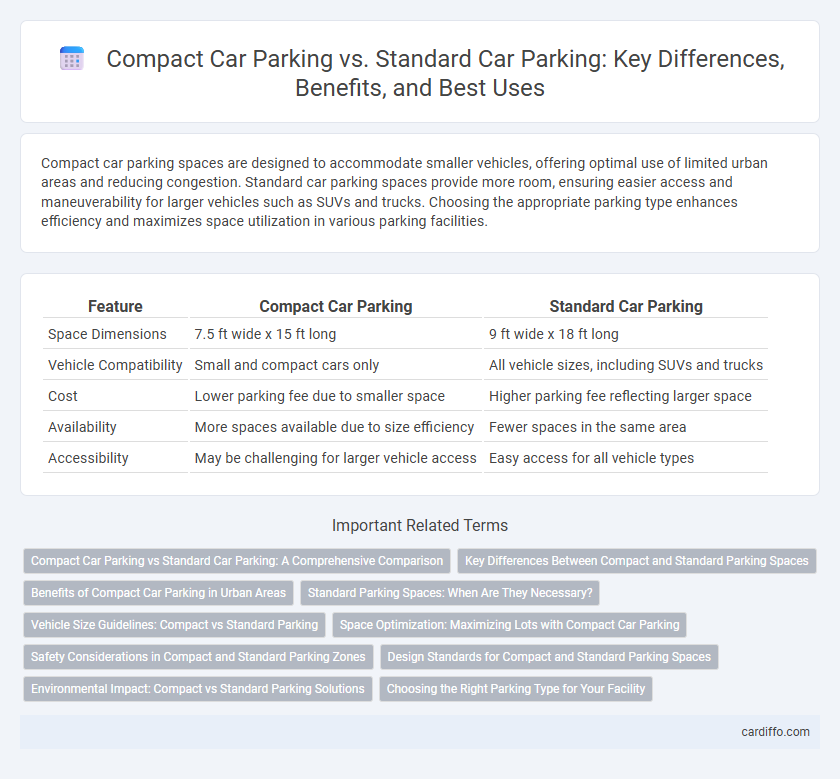Compact car parking spaces are designed to accommodate smaller vehicles, offering optimal use of limited urban areas and reducing congestion. Standard car parking spaces provide more room, ensuring easier access and maneuverability for larger vehicles such as SUVs and trucks. Choosing the appropriate parking type enhances efficiency and maximizes space utilization in various parking facilities.
Table of Comparison
| Feature | Compact Car Parking | Standard Car Parking |
|---|---|---|
| Space Dimensions | 7.5 ft wide x 15 ft long | 9 ft wide x 18 ft long |
| Vehicle Compatibility | Small and compact cars only | All vehicle sizes, including SUVs and trucks |
| Cost | Lower parking fee due to smaller space | Higher parking fee reflecting larger space |
| Availability | More spaces available due to size efficiency | Fewer spaces in the same area |
| Accessibility | May be challenging for larger vehicle access | Easy access for all vehicle types |
Compact Car Parking vs Standard Car Parking: A Comprehensive Comparison
Compact car parking spaces typically measure around 7.5 to 8 feet wide and 15 to 16 feet long, designed to accommodate smaller vehicles like sedans and hatchbacks efficiently. Standard car parking spaces are larger, approximately 8.5 to 9 feet wide and 18 to 20 feet long, providing more room for SUVs, trucks, and larger cars, which enhances ease of entry and exit. Choosing between compact and standard parking impacts lot capacity, with compact spaces allowing for more vehicles per area, while standard spaces offer greater vehicle accommodation flexibility.
Key Differences Between Compact and Standard Parking Spaces
Compact car parking spaces typically measure around 7.5 to 8 feet in width and 15 to 16 feet in length, designed to accommodate smaller vehicles efficiently. Standard car parking spaces are larger, usually about 8.5 to 9 feet wide and 18 to 20 feet long, providing more maneuvering room for midsize and larger cars. The key differences lie in size specifications, which impact vehicle fit, ease of parking, and the overall utilization of parking lot space.
Benefits of Compact Car Parking in Urban Areas
Compact car parking in urban areas maximizes space efficiency by accommodating smaller vehicles in tighter spots, increasing the total number of available parking spaces. This optimization reduces congestion and improves traffic flow on crowded city streets by minimizing the area required for each parked car. Additionally, compact parking supports environmental sustainability by encouraging the use of smaller, more fuel-efficient vehicles, leading to lower emissions in densely populated regions.
Standard Parking Spaces: When Are They Necessary?
Standard parking spaces, typically measuring 8.5 to 9 feet wide and 18 to 20 feet long, are necessary for vehicles larger than compact cars, such as SUVs, trucks, and minivans, ensuring sufficient room for easy maneuvering and door opening. These spaces accommodate drivers with disabilities who require extra space for mobility aids, as well as families needing additional room to load and unload children or cargo. Commercial and public parking facilities often allocate more standard parking spots to handle diverse vehicle sizes and enhance overall safety and accessibility.
Vehicle Size Guidelines: Compact vs Standard Parking
Compact car parking spaces are typically designed to accommodate vehicles up to 16-17 feet in length and 6 feet in width, ideal for small sedans, hatchbacks, and compact SUVs. Standard car parking spaces generally measure around 18-20 feet in length and 7-8 feet in width, suitable for midsize and full-size vehicles including larger SUVs and pickup trucks. Following these vehicle size guidelines ensures efficient use of parking areas, reduces congestion, and improves overall safety in parking facilities.
Space Optimization: Maximizing Lots with Compact Car Parking
Compact car parking spaces typically measure around 7 feet wide by 15 feet long, allowing for increased lot density compared to standard spaces averaging 9 feet by 18 feet. By allocating more compact spots, parking facilities can maximize the total number of vehicles accommodated without expanding the lot footprint. This space optimization strategy improves lot utilization efficiency, reduces paving costs, and supports urban areas where land availability is limited.
Safety Considerations in Compact and Standard Parking Zones
Compact car parking zones are designed with tighter dimensions that require precise maneuvering, increasing the risk of minor collisions and scratches if drivers are not cautious. Standard car parking spaces offer more room for entry and exit, reducing the likelihood of door dings and side-swipes, thereby enhancing overall safety. Proper signage and adequate lighting in both compact and standard parking areas are crucial to minimizing accidents and ensuring pedestrian safety.
Design Standards for Compact and Standard Parking Spaces
Design standards for compact car parking spaces typically require dimensions around 7.5 to 8 feet in width and 15 to 16 feet in length, accommodating smaller vehicle profiles while maximizing lot efficiency. Standard parking spaces measure approximately 8.5 to 9 feet wide and 18 to 20 feet long, designed to fit a wider range of vehicle sizes, including SUVs and trucks. These dimensional guidelines ensure safety, ease of maneuverability, and compliance with municipal regulations, influencing overall parking lot capacity and user convenience.
Environmental Impact: Compact vs Standard Parking Solutions
Compact car parking spaces reduce land use by approximately 30%, leading to decreased environmental disruption and lower urban heat island effects. Standard car parking requires more asphalt and concrete, increasing stormwater runoff and pollutant accumulation, which harms local ecosystems. Choosing compact parking solutions minimizes carbon footprints through efficient space utilization and supports sustainable urban development goals.
Choosing the Right Parking Type for Your Facility
Selecting the appropriate parking type hinges on the typical vehicle sizes frequenting your facility, where compact car parking optimizes space by fitting smaller vehicles into narrower spots, increasing overall lot capacity. Standard car parking accommodates larger vehicles, ensuring ease of access and reducing the risk of vehicle damage. Evaluating vehicle demographics, turnover rates, and spatial constraints ensures efficient utilization of parking areas and enhances user satisfaction.
Compact Car Parking vs Standard Car Parking Infographic

 cardiffo.com
cardiffo.com